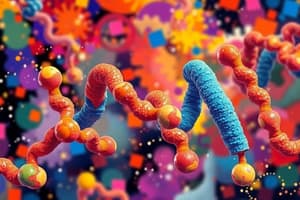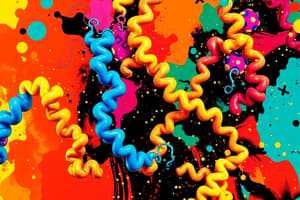Podcast
Questions and Answers
Which category of amino acids can be synthesized by the body?
Which category of amino acids can be synthesized by the body?
- Dispensable (nonessential) amino acids (correct)
- Conditionally dispensable amino acids
- Indispensable (essential) amino acids
- Both conditionally dispensable and indispensable amino acids
Which type of amino acid may become essential under specific health conditions?
Which type of amino acid may become essential under specific health conditions?
- Indispensable (essential) amino acids
- Amino acids with amine and carboxylic acid groups
- Conditionally dispensable amino acids (correct)
- Dispensable (nonessential) amino acids
What is the main function of amino acids in the body?
What is the main function of amino acids in the body?
- To serve as the building blocks for proteins (correct)
- To provide energy
- To regulate body temperature
- To control the genetic code encoded within DNA
Which of the following is not a property of indispensable (essential) amino acids?
Which of the following is not a property of indispensable (essential) amino acids?
Which type of amino acid is typically nonessential under normal conditions but may become essential under stressful situations?
Which type of amino acid is typically nonessential under normal conditions but may become essential under stressful situations?
What is the process by which the genetic code encoded within DNA is translated into specific sequences of amino acids, forming a unique protein structure?
What is the process by which the genetic code encoded within DNA is translated into specific sequences of amino acids, forming a unique protein structure?
Which of the following amino acids is considered essential?
Which of the following amino acids is considered essential?
Which type of protein provides mechanical strength and elasticity to structures like tendons and ligaments?
Which type of protein provides mechanical strength and elasticity to structures like tendons and ligaments?
What do proteins with high biological value provide in terms of essential amino acids?
What do proteins with high biological value provide in terms of essential amino acids?
Which type of protein catalyzes biochemical reactions in the body?
Which type of protein catalyzes biochemical reactions in the body?
What is a characteristic of globular proteins in terms of solubility?
What is a characteristic of globular proteins in terms of solubility?
Which of the following is true regarding low biological value (LBV) proteins?
Which of the following is true regarding low biological value (LBV) proteins?
Flashcards are hidden until you start studying
Study Notes
Protein Molecular Structure
Proteins are complex organic compounds consisting of amino acids, the building blocks of life. Their molecular structures vary greatly depending on the types of amino acids they contain and how they are organized. Through the process of translation, the genetic code encoded within DNA is translated into specific sequences of amino acids, forming a unique protein structure tailored to its function in the organism.
Amino Acids
Amino acids are organic compounds containing an amine group (-NH2) and a carboxylic acid group (-COOH). They serve as the building blocks for proteins and play essential roles in various biological processes. There are three categories of amino acids based on their properties: dispensable (or nonessential), conditionally dispensable, and indispensable (or essential).
Dispensable (Nonessential) Amino Acids
These amino acids are synthesized by the body and can be manufactured from other amino acids. Examples include Alanine, Aspartic acid, Asparagine, Glutamic acid, Serine, Glycine, Proline, and Tyrosine.
Conditionally Dispensable Amino Acids
Conditionally dispensable amino acids are typically nonessential under normal conditions but may become essential under stressful situations or specific health conditions. Arginine, Cysteine, Glutamine, Glycine, Proline, and Tyrosine fall into this category.
Indispensable (Essential) Amino Acids
Indispensable amino acids are essential nutrients that cannot be formed by the body and must be obtained through the diet. Nine amino acids are recognized as essential: Histidine, Isoleucine, Leucine, Lysine, Methionine, Phenylalanine, Threonine, Tryptophan, and Valine.
The presence of essential amino acids in a protein determines its biological value, or how effectively it matches the body's needs for these critical nutrients.
Types of Protein
There are four primary classes of proteins based on their structure and function: fibrous proteins, globular proteins, membrane proteins, and enzyme proteins.
Fibrous Proteins
Fibrous proteins consist mostly of amino acid chains folded into stable, rod-like structures. They provide mechanical strength and elasticity to structures like tendons, ligaments, and muscles.
Globular Proteins
Globular proteins have spherical shapes and are soluble in water due to their hydrophilic nature. They perform a wide range of functions in the body, including acting as enzymes, hormones, and antibodies.
Membrane Proteins
Membrane proteins are embedded in the lipid bilayer of cell membranes, spanning across the membrane or extending into both layers. They facilitate communication between cells and regulate the passage of molecules across the cell membrane.
Enzyme Proteins
Enzyme proteins, also known as enzymes, catalyze biochemical reactions in the body. They improve reaction rates and selectivity, allowing the body to maintain homeostasis and carry out numerous metabolic processes efficiently.
Low Biological Value vs. High Biological Value Proteins
The concept of biological value in proteins refers to their ability to meet the body's requirements for essential amino acids. High biological value (HBV) proteins are those that provide all the essential amino acids in the proportions needed by humans, whereas low biological value (LBV) proteins may be deficient in one or more essential amino acids.
Animal-derived proteins like meat, poultry, fish, eggs, milk, cheese, and yogurt generally have a higher biological value than plant-derived proteins like grains, legumes, nuts, and seeds.
Studying That Suits You
Use AI to generate personalized quizzes and flashcards to suit your learning preferences.




